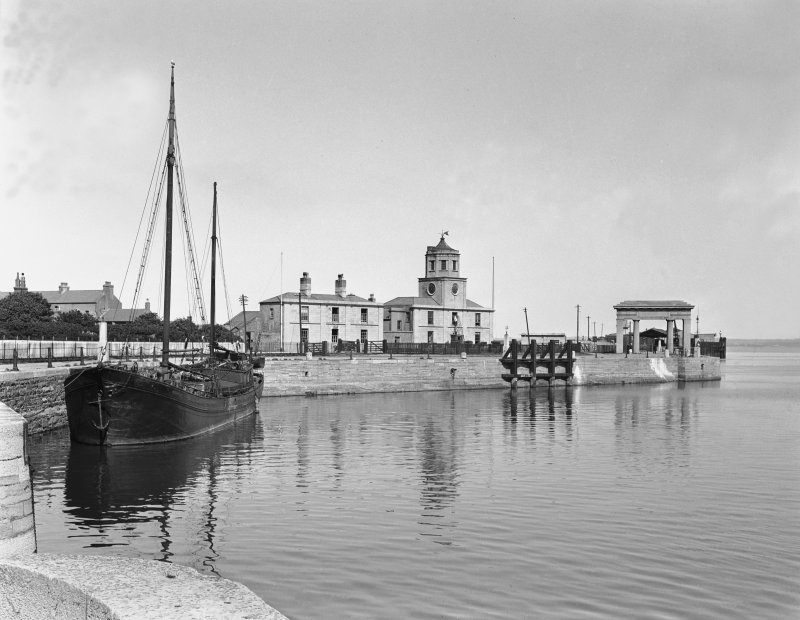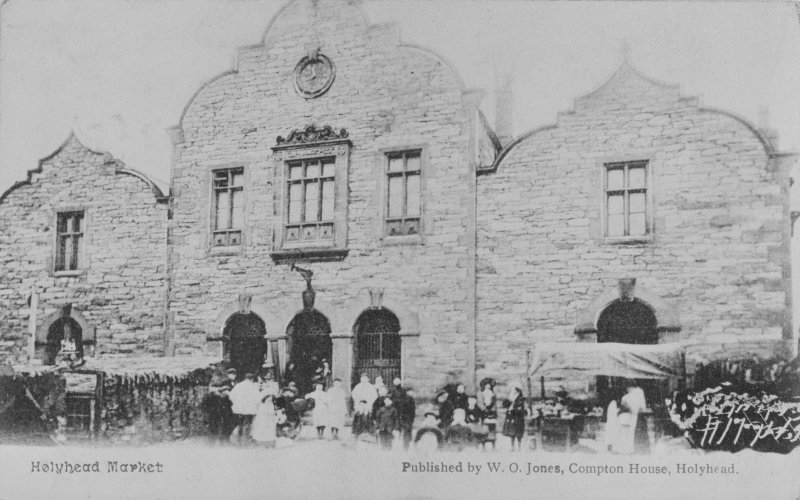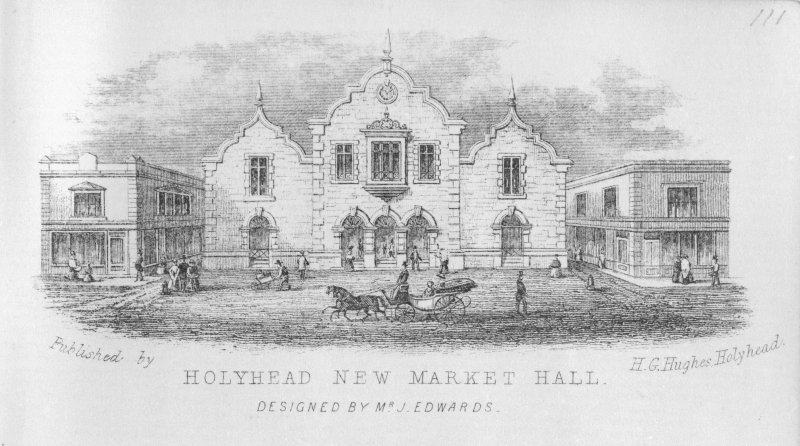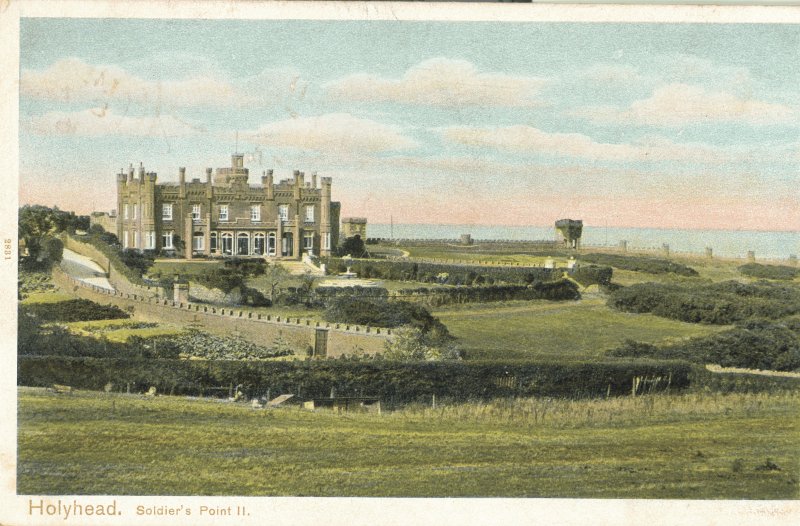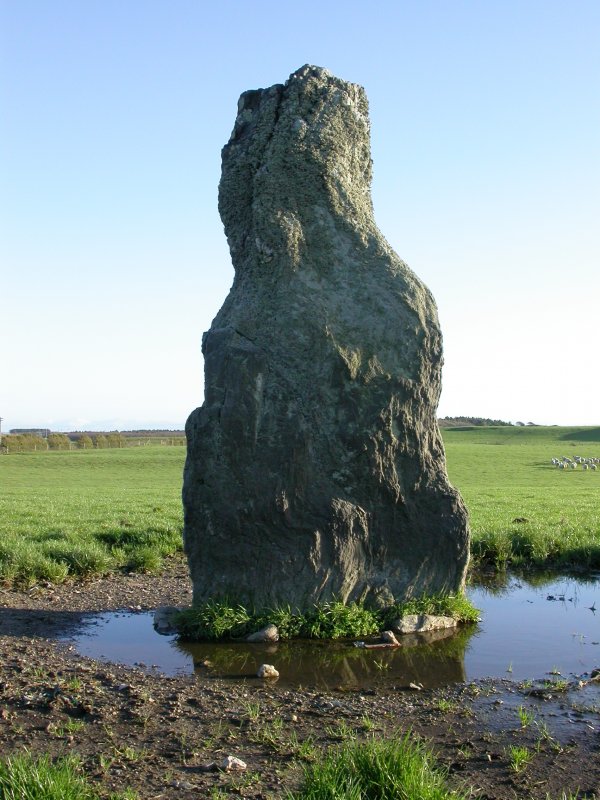Holyhead - Overview
Holyhead, on Holy Island, is the largest town on Anglesey and is a major sea port with a ferry link to Ireland. This corner of the island is dotted with remains of circular huts, burial chambers and standing stones giving evidence of human settlements here at least since the Neolithic. In the fourth century, the Romans built a fort, Caer, here which probably served as an outpost of Segontium (near Caernarfon). In the sixth century, Saint Cybi founded a church and monastery on the site of the former camp. The Welsh name of Holyhead, Caergybi, therefore shows the town’s Roman and early Christian origins.
For many centuries, Holyhead served as main communications link with Ireland, but Telford’s A5 road, including the Menai Suspension Bridge, and the arrival of the Chester and Holyhead railway in 1844, contributed greatly to the growth of the town. The increased sea traffic made it necessary to develop a new harbour capable of accommodating up to 1000 vessels. Holyhead breakwater was built at the same time to make this ‘New Harbour’ storm proof for ships anchored there, and at 3km is Britain’s longest.
Picturesquely situated on a small rocky island below towering cliffs, the lighthouse at South Stack is not only evidence of Holyhead’s historical importance for shipping, but also of the treacherous rocks below water. Originally built in 1809, it is still in operation and open to visitors today. In the nineteenth century, large colonies of sea birds nested on these cliffs and many tourists came to South Stack Lighthouse to enjoy the spectacle of thousands of shrieking gulls careening through the air.
Accounts of Travel
Briefe eines Verstorbenen, 1828
Hermann von Pückler-Muskau (1785 – 1871)
So krank und matt ich bin, hat mir doch die Exkursion nach dem neu erbauten, 4 Meilen entfernten Leuchtthurme, ungemein viel Vergnügen gewährt. Obgleich die Oberfläche der Insel Anglesea sehr flach erscheint, so erhebt sie sich doch, am Ufer der irländischen See, in höchst malerischen, abgerissenen Felsenwänden, bedeutend hoch aus den stets brandenden Fluthen. Auf einem solchen, vom Ufer etwas entfernten, einzeln hervorragenden Felsen, steht der Leuchtthurm. Nicht nur senkrecht, sondern unter sich zurückweichend, fallen diese, über alle Beschreibung wilden Gestade, mehrere hundert Fuß tief nach dem Meere hinab, und sehen aus, als seyen sie durch Pulver gesprengt, nicht von der Natur so gebildet. Auf einem dichten Teppich von kurzem gelben Ginster und karmoisinrother Haide, gelangt man bis an den Rand des Abhangs, dann steigt man auf einer roh in den Stein gehauenen Treppe, von 4 bis 500 Stufen, bis zu einem in Stricken hängenden Stege hinab, auf dem man sich, an die Seitennetze anhaltend, über den Abgrund, der beide Felsen trennt, so zu sagen, hinüber schaukelt. Tausende von Seemöven, die hier zu brüten pflegen, umschwebten uns auf allen Seiten, unaufhörlich ihre melancholische Klage durch den Sturm rufend. Die Jungen waren erst kürzlich flügge geworden, und die Alten benutzten wahrscheinlich das ungestüme Wetter zu ihrer Einübung. Man konnte nichts Graziöseres sehen als diese Fluglektionen. Leicht erkannte man die Jüngeren an ihrer grauen Farbe und ihrem noch ungewissen Schwanken, während die Alten, fast ohne einen Flügel zu rühren, minutenlang, blos vom Sturm gehalten, wie in der Luft versteinert hingen. Die jungen Vögel ruhten auch öfters in den Felsenspalten aus, wurden aber von ihren strengen Aeltern immer schnell wieder zu neuer Arbeit genöthigt.
Der Leuchtthurm ist völlig dem bereits erwahnten in Flamboroughhead an der englischen Ostküste gleich, nur ohne rothe revolving lights. Auch hier war die Nettigkeit der Oehlkeller und die außerordentliche Reinlichkeit der spiegelblanken Lampen bewunderungswerth. Außerdem bemerkte ich eine ingenieuse Art Sturmfenster, die man ohne Mühe und Gefahr des Zerbrechens, auch beim heftigsten Winde, öffnen kann, und eine vertikale Steintreppe, gleich einer gezackten Säge, die viel Raum erspart. Beide Gegenstände lassen sich jedoch ohne Zeichnung nicht ganz anschaulich machen.
Ill and languid as I am, an excursion to the newly built lighthouse, four miles from hence, has given me extraordinary pleasure. Although the Island of Anglesea appears very flat, its picturesque craggy rocks rise on the western shore to a very considerable height above the sea. On one of these rocks, which stands out to sea, abrupt and isolated, is placed the light-house. This indescribably wild cliff is not only perpendicular – the summit actually projects several hundred feet beyond the line of the base; so that it appears rather as if blasted by powder, than the work of nature. Treading on a thick carpet of yellow dwarf broom and crimson heath, you reach the edge of the precipice: you then descend four or five hundred steps, roughly hewn in the rock, till you come to a little bridge suspended on ropes; across this, holding by its net-work sides, you swing, as it were, over the chasm which separates this rock from the main land. Thousands of sea-mews wheeled around us, uttering their ceaseless melancholy wail to the storm. The young ones were just fledged, and the parent birds took advantage of the rough weather to exercise them. Nothing could be more graceful and interesting than these flying lessons. The young were easily distinguished by their gray colour and their yet unsteady flight; while the old ones hung poised sometimes for the space of a minute without moving a wing, as if upborne motionless by the storm. The young ones often rested in the crevices of the rocks, but were soon driven out to fresh exertions by their inexorable parents.
The light-house is exactly like that which I have described to you at Flamborough Head, on the eastern coast of England, only without the revolving lights. The neatness of the oil-vessels, and the wonderful brightness of the mirror-like reflectors were here, as there, most admirable. I remarked an ingenious sort of rough-weather window, which may be opened in the hardest gale, without trouble or danger of breaking; and a vertical stone staircase, like a saw, which saves much room. But I cannot make you understand either without a drawing.
(Tour in England, Ireland, and France, in the Years 1828 & 1829. With Remarks on the Manners and Customs of the Inhabitants, and Anecdotes of Distinguished Public Characters. In a Series of Letters. By a German Prince. Ed. B –. Vol. 1. London: Effingham Wilson, 1832)
Skizzen und Erzählungen aus Irland, c. 1850s
Adolf Helfferich (1813 – 1894)
Die Krone läßt in Holyhead in diesem Augenblick einen Hafen bauen, der an Großartigkeit den Hafen von Kingstown [Dún Laoghaire in Ireland] noch weit übertreffen wird. Vermittelst dreier Locomotiven werden aus den eine halbe Meile entfernten Steinbrüchen fortwährend Steinmassen in das über 50 Fuß tiefe Meer geschüttet. Die Unternehmner bedienen sich dabei galvanischer Batterien zum Anzünden der ganz colossalen Pulvermassen, durch welche die Felsen gesprengt werden. Zu einer einzigen Ladung in drei verschiedenen Minen wurden nicht weniger als 5000 Tonnen Pulver verwendet und die Explosion war so gewaltig, daß 36.000 Tonnen Steine in die Luft flogen. Viele Steine haben 20 Tonnen an Gewicht. Zur Herstellung des ganzen sind 5-6 Millionen Tonnen erforderlich, wovon bereits über eine Million am Meeresgrunde liegt. Von 12 bis 1500 Arbeitern werden täglich 4000 Tonnen beschafft. Die Basis des Dammes ist 600 Fuß breit; der Pier soll eine Länge von 2000 Fuß bekommen.
The Crown is currently constructing a harbour in Holyhead whose magnificence will surpass that of the harbour at Kingstown [Dún Laoghaire in Ireland] by far. With the help of three locomotives, masses of stone from the quarries half a mile distant are continuously deposited in the 50 feet deep sea. For this purpose, the contractors employ galvanic batteries to ignite the colossal amounts of black powder necessary for blasting the rock. For just one blast across three different mines, 5000 tons of powder were used and the explosion was so enormous that 36,000 tons of stone were blown asunder. Many of these boulders weigh 20 tons. Five to six million tons will be required for the entire construction, of which over half a million lie already at the bottom of the sea. Between twelve and fifteen hundred workers produce 4000 tons daily. The base of the dam measures 600 feet and the pier is intended to be 2,000 feet long.
"Pays de Galles", 1846
Pierre Trabaud ( – )
Holyhead est tout à la fois un rocher et une île; c’est plus qu’un rocher, moins qu’une île. On l’aperçoit de fort loin, à cause de sa couleur blanche qui se détache sur les teintes variées du ciel et de la mer d’Irlande. Gracieux point blanc à l’horizon, il a été invoqué des milliers de fois, et a donné aux uns, à ceux qui l’approchent de l’espoir et du regret aux autres, à ceux qui le quittent. Le port y est sûr, garanti du nord et de l’ouest, de sorte qu’en venant de Dublin, vent arrière ou sur le flanc, on prend l’entrée au large et l’on arrive par le golfe situé entre l’île d’Holyhead et celle d’Anglesea. Il paraît que la position d’Holyhead est jugée bonne par la marine du commerce et la marine de l’état qui y trouve un point de défense à l’occident de la Grande-Bretagne. Le port, quand nous y entrâmes, avait une animation, une gaîté qui me charmait. Ah! Si nos petits ports avaient cet aspect remuant, cette tournure apprêtée, cet apparat maritime, ces chantiers, ce peuple de marins toujours en activité de services! Il est impossible de ne pas songer à la belle France, quand on est français et qu’on voudrait donner à sa patrie tout ce qui lui manque, tout ce que possèdent les autres nations et les nations voisines et puissantes avant toutes les autres. Tout ici respire le succès. Il faut voir avec quelle habilité tous les îlots de cette pointe où nous venons d’aborder, sont liées entr’eux par des môles, des murailles et des ponts suspendus au besoin, puis tous ces ouvrages de castors patients et opiniâtres, éclairés le soir par des phares resplendissants qui indiquent aux nautonniers l’approche de cette côte ardue, souvent inhospitalière.
Holyhead is both a rock and an island: it is more than a rock but less than an island. It can be spotted from afar, thanks to the white colour that stands out against the varied tones of the sky and the Irish sea. Graceful white point on the horizon, it has been hailed a thousand times and given to those who approach it hope, and to those who leave it regret. The port is secure, protected to the north and the west, such that on approaching from Dublin, with a tailwind or a sidewind, you go through the entrance from the open sea and arrive via the gulf situated between the islands of Holyhead and Anglesey. It seems that Holyhead’s position is judged to be good by both the merchant navy and the military, for whom it is a point of defence on the west of Great Britain. When we entered the port I found the animation and gaiety most charming. Ah! If only our little ports had such a look of bustle, of readiness, and such maritime pomp, construction, and seafaring people always busy at work! It is impossible not to think of fair France, when you are French and you would like to give your fatherland all that it lacks, all that which other nations, and particularly neighbouring powerful nations have. Everything here radiates success. You have to see how skilfully all the little islands of this point that we’ve just reached, are interconnected by breakwaters, walls and suspension bridges as needed, and then all the work of builders beavering away with patience and persistence, lit up at night by dazzling lighthouses that signal to sea captains [the one who navigates] the approach of this arduous and often inhospitable coast.
Itinéraire et souvenirs d’Angleterre et d’Ecosse, 1814-1826, 1826
Basile-Joseph Ducos (1767 – 1836)
Holyhead est situé au nord d’une petite île qui communique par un pont, avec la côte occidentale de celle d’Anglesey. C’est là que l’on s’embarque communément pour Dublin. La distance est de vingt lieues que l’on fait en huit heures. Chaque jour il part un paquebot pour cette destination. La fréquentation de ce port y a attiré quelque commerce. En venant de la ville, on y entre par une espèce de porte triomphale. La jetée qui le ferme est revêtue en maçonnerie. A l’extrémité s’élève un fanal. Des grues, des hangars garnissent ses quais spacieux. Tous ces ouvrages sont récens. La côte est semée d’écueils. D’énormes masses de rochers arrachés du rivage, y forment des cavernes où les vagues s’engouffrent avec un bruit horrible. Les oiseaux de mer se plaisent parmi ces remous, au sein des brisans. Ils se jouent dans les flots d’écume qui s’envolent comme des nuages; ou, perchés sur des pics inabordables, ils bravent la lame qui les baigne à chaque instant et se retire aussitôt. Près de nous de pauvres Irlandais regardaient ce spectacle attrayant.
Holyhead is situated to the north of a small island that is connected by bridge to the western coast of Anglesey. This is the usual embarkation point for Dublin. The distance is twenty leagues and is covered in eight hours. Every day a steamship leaves for this destination. The busyness of this port has attracted some commerce. Arriving from the town you enter it by a sort of triumphal gate. The jetty that closes it is covered in stonework. At the far end stands a beacon. Cranes and hangars fill the spacious quays. All this work is recent. The coastline is strewn with reefs. Enormous masses of rock, ripped from the shore, form caves there where the waves surge with a horrible noise. The sea birds enjoy being among these eddies, in the midst of breakers. They play in the waves of spume that take flight like clouds; or, perched on inaccessible peaks, they play dare with the crest that now soaks them now withdraws. Near us some poor Irish people were watching this attractive show.

